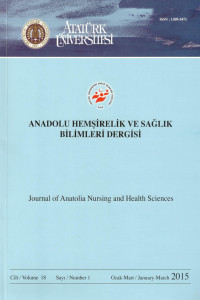Öz
Objective: The purpose of the study is to investigate the changing of nursing students’ submissive acts who undergone Problem Based Learning Model.
Method: The participants of research consisted of 53 nursing students who have started nursing education in 2003-2004 academic year and also the students who are still in the fourth class in 2006-2007 academic year. The data of each year have been collected completely from the students. It was used the data of sociodemographic questionnare which collected in 2005-2006 academic year for evaluating of the students’ sociodemographic characteristics. The Submissive Act Scale has been applied to the nursing students in the first semester of academic year in 2006-2007.
Results: The study have done with Submissive Act Scale, it has defined that nursing students’ submissive acts scores who undergone Problem Based Learning are the highest in first class (37.28±5.65), and the scores decreases as the years goes by although the scores are similar in the second (32.28±6.06), third (32.67±5.37) and fourth (32.32±7.55) classes (F=3373.598; p=.000).
Conclusion: It has defined that nursing students’ SAS scores who undergone PBL decreases by the years. The results that obtained from this study revealed that it is suggested that nursing students’ SAS scores who undergone PBL and traditional education method must be compared.
Anahtar Kelimeler
PROBLEME DAYALI ÖĞRENİM MODELİ İLE EĞİTİM GÖREN HEMŞİRELİK ÖĞRENCİLERİNİN BOYUN EĞİCİ DAVRANIŞLARINDAKİ DEĞİŞİMİN İNCELENMESİ*
Öz
Amaç: Araştırmanın amacı, probleme dayalı öğrenim modeliyle eğitim gören hemşirelik öğrencilerinin boyun eğici davranışlarındaki değişimi incelemektir.
Yöntem: Araştırmaya katılan öğrenciler 2003-2004 akademik yılında hemşirelik eğitimine başlayan ve 2006-2007’de son sınıfa gelmiş olan öğrencilerden her bir yıl için verileri eksiksiz olarak toplanmış 53 öğrenciden oluşmaktadır. Bu öğrenci grubuna 2006-2007 akademik yılı güz döneminde Boyun Eğici Davranış Ölçeği uygulanmıştır. Öğrencilerin sosyodemografik özelliklerinin değerlendirilmesinde 2005-2006 akademik yılında toplanan sosyodemografik özellikler anket formunun verileri kullanılmıştır.
Bulgular: Probleme dayalı öğrenim modeli ile eğitim gören hemşirelik öğrencilerinin boyun eğici davranış puanlarının en fazla 1. sınıfta olduğu (37.28±5.65), yıllar içerisinde azalmakla birlikte 2. (32.28±6.06) 3. (32.67±5.37) ve 4. sınıfta (32.32±7.55) bu puanların benzerlik gösterdiği belirlenmiştir (F=3373.598; p=.000).
Sonuç: Probleme Dayalı Öğrenim modeli ile eğitim gören hemşirelik öğrencilerinin yıllar içerisinde boyun eğici davranışlarının azaldığı saptanmıştır. Boyun eğici davranış özelliklerinin azaltılmasında eğitimin etkinliğini belirlemek için geleneksel ve Probleme Dayalı Öğrenim modeli ile eğitim gören hemşirelik öğrencilerinin boyun eğici davranışlarının karşılaştırılması önerilmektedir.
Anahtar Kelimeler
Ayrıntılar
| Birincil Dil | Türkçe |
|---|---|
| Konular | Sağlık Kurumları Yönetimi |
| Bölüm | Makaleler |
| Yazarlar | |
| Yayımlanma Tarihi | 30 Mart 2015 |
| Gönderilme Tarihi | 25 Haziran 2013 |
| Yayımlandığı Sayı | Yıl 2015 Cilt: 18 Sayı: 1 |
Cited By
Dergimiz 2019 dan itibaren EBSCO CINAHL Database'de listelenmektedir.
Anadolu Hemşirelik ve Sağlık Bilimleri Dergisi Creative Commons Attribution-NonCommercial 4.0 (CC BY-NC 4.0) ile lisanslanmıştır.

